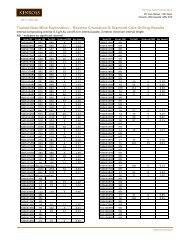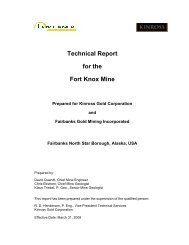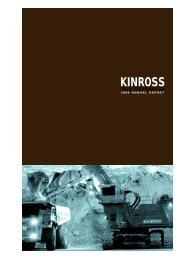Technical Report for the Maricunga Gold Mine - Kinross Gold
Technical Report for the Maricunga Gold Mine - Kinross Gold
Technical Report for the Maricunga Gold Mine - Kinross Gold
- No tags were found...
Create successful ePaper yourself
Turn your PDF publications into a flip-book with our unique Google optimized e-Paper software.
<strong>Kinross</strong> <strong>Gold</strong> Corporation<strong>Maricunga</strong> <strong>Mine</strong> <strong>Technical</strong> <strong>Report</strong>evaluate crush size sensitivity of <strong>the</strong> Pancho ore. <strong>Gold</strong> recovery increased incrementally (3%- 6%), by crushing from 15.9mm to 9.5mm in size. <strong>Gold</strong> recoveries obtained from bothcomposites were essentially <strong>the</strong> same at <strong>the</strong> 9.5mm and 6.3mm feed sizes.Column test gold recovery rates <strong>for</strong> <strong>the</strong> 2240, Pancho 6, CCT and Oxide composites wererapid, and gold extraction was substantially complete in about 25 days of leaching. <strong>Gold</strong>recovery rates were slower, and gold extraction progressed at a slow, but significant rateafter 75 days of leaching, <strong>for</strong> <strong>the</strong> 1690, 1840, 1930 and 2140 composites. The slowest goldrecovery rates observed were <strong>for</strong> <strong>the</strong> 1840 Shallow and RHEVC composites.Column test cyanide consumptions generally were high, but were not as strongly correlatedto copper head grade, as seen during bottle roll testing. Column test cyanide consumptionstended to increase with increasing leach solution application, as normally expected <strong>for</strong>column leach tests. Because some of <strong>the</strong> column test leach cycles were relatively long induration (>140 days), <strong>the</strong> resulting cyanide consumptions were relatively high. Averagecolumn test cyanide consumption (6.3mm feeds) was 2.39 kg NaCN/mt ore.Column test lime additions were made based on corresponding bottle roll test limerequirement data. Lime requirements <strong>for</strong> <strong>the</strong> drill core composites varied substantially. Initialcolumn test lime additions ranged from 1.8 to 13.0 kg/mt ore. Those lime additions weresufficient <strong>for</strong> maintaining protective alkalinity during leaching, <strong>for</strong> most of <strong>the</strong> composites.Minor pH control problems were encountered during leaching of <strong>the</strong> 2140 and 2240composites, and relatively small lime additions were made to <strong>the</strong> column test barrensolutions during leaching, to help control leaching pH. Severe pH control problems wereencountered during leaching of <strong>the</strong> Oxide and CCT composites, and <strong>the</strong> lime added duringleaching <strong>for</strong> pH control was equivalent to more than <strong>the</strong> lime added to <strong>the</strong> ore initially. Thehighest observed combined lime requirement was 41.1 kg/mt ore, <strong>for</strong> <strong>the</strong> Oxide composite9.5mm column feed. Higher initial lime additions should be evaluated <strong>for</strong> <strong>the</strong>se ore types todetermine whe<strong>the</strong>r or not pH control will be a problem during commercial heap leaching.Overall, reagent consumption data indicate potential concerns during commercial heapleaching of <strong>the</strong> Pancho ore, with respect to high cyanide consumptions related to copperdissolution, and high lime consumptions related possibly to interaction with sulphatesnaturally occurring in <strong>the</strong> ore. Follow-up testing was recommended to better establish baserequirements <strong>for</strong> pH control during heap leaching of <strong>the</strong> higher lime consuming Pancho ores.70
















